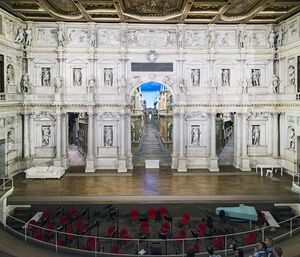Corrales de Comedias are rectangular courtyards, about 30 to 40 m long and 15 to 17 m wide, in which theatre was performed from the beginning of the Renaissance, surrounded by private houses, some of which had barred windows and balconies from which one could watch the performance on the raised stage.
"Haçese rruydo debajo del tablado con un barril lleno de piedras." (Noise is made, with a barrel full of stones under the stage). This sentence from the 1585 work Numancia by Miguel de Cervantes tells of an acoustic effect. In the same year, the Teatro Olimpico was built in Vicenza/Italy, the "first permanent inhouse theatre building" after antiquity.
The Golden Age, which coincides with the rise of the Spanish Empire, owes its name to the heyday of Spanish literature: from 1492, the year of the "discovery" of America and the publication of the Castilian Grammar - to 1681, the year of the death of Pedro Calderón de la Barca.
Other authors include Sor Juana Inés de la Cruz (1648-1695), Miguel de Cervantes (1547-1616) and Lope de Vega (1562-1635). Just as there were some female playwrights, female actors were also allowed from 1587 onwards, which is an unusual feature in the rest of the European continent.
Inseparable from the development of dramatic literature were the physical conditions that made the existence of theatre possible: the creation of venues and ensembles, the organisation of audiences and the infrastructure as a whole. However, performances with an almost daily programme, general audience access and in this variety only took place in Spain, where the (tragic) comedies were performed by professional companies.
The foundation of public theatres coincided with the arrival of Italian commedia dell'arte performers in 1574, who influenced Spanish actor:ing and helped the Madrid brotherhoods distribute, furnish and build theatres. The brotherhoods, public organisations, drew their funds from the entrance fees, introduced in a structured way for the first time.
The first performance in the Corral del Príncipe in Madrid took place in 1583. By 1630, the Príncipe had exhausted its capacity for growth, as the seating capacity had increased from 1000 to 2000 spectators since the first opening. In the Corral de Comedias de Alcalá commercial theatre began 1601 with Francisco Sánchez, who bought a house and fenced off the backyard, because he was impressed by Madrid's nearby Corral de la Cruz and sensed a promising low-capital business model in the entertainment industry.
The men watched the spectacle standing outside; at the end of the courtyard gathered the mosqueteros (musketeers), noisy soldiers. At the sides were the galleries with rooms for the monarchy, in neighbouring estates, open to the courtyard and rented out for the entire season. Opposite the stage was another wooden gallery: the upper floor for the clergy and the city's notables. Below this was the women's "cazuela", in the area immediately adjacent to the entrance.
The basic scenery consisting of the two horizontally superimposed galleries of the back wall with two vertical wooden supports offered a total of nine niches that could be used independently for different stage effects. Their railings were removable to install elements such as city walls, stairs or towers. Each of these spaces was covered with curtains behind which small scenes could be prepared. They were then opened for the audience to imagine the different places of action according to the verses, e.g. a banquet scene or an actress at her dressing table. As in Shakespeare's theatre, which developed almost simultaneously, these are only suggested with simple props: an armchair and a small table as a cabinet; some branches or rocks to represent a garden. The so-called "Spoken Decoration" contains only hints and works with the audience's imagination based on the very figurative language.
Above the stage and the upper corridor, hidden by the canopy, was the attic where the stage machinery was housed, which explains the robustness of the roof construction. From here, elements such as clouds could be lowered. This attic also had a wooden floor with hatches, directly above the lower hatches in the galleries, to make room for the ropes from which the counterweights of the stage sets hung. The hatches both in the stage and in the niches of the galleries were usually connected with a lifting mechanism based on pulleys. This allowed for several types of movement:
- A horizontal movement, between the (imagined) outside of a street and the inside of a house.
- A transformation in depth between the visible world on stage and an invisible dream world mounted in one of the gallery niches.
- A vertical connection between the spiritual above in the niches, the earthly on stage and the hellish below, connected by the hatch in the floor.
The only one that has been completely preserved is the corral in Almagro (1628), where the International Festival of Classical Theatre is held annually.


